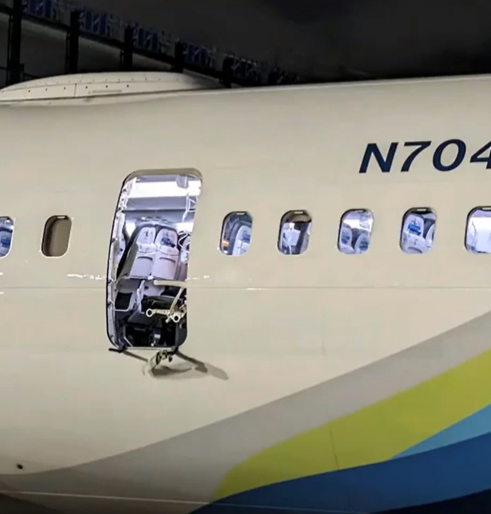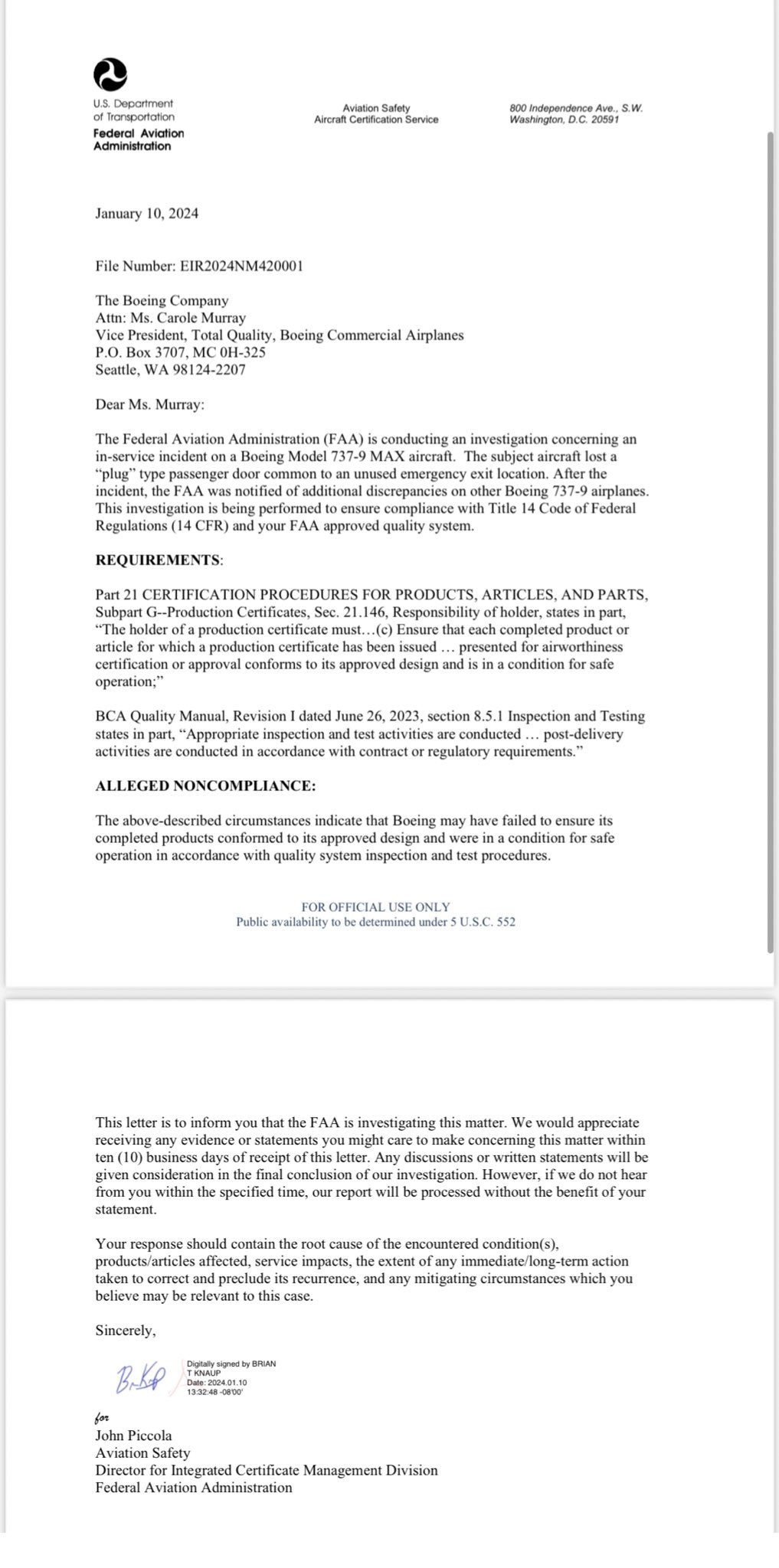Leeham News and Analysis
There's more to real news than a news release.
NTSB confirms door plug bolts were missing on Boeing 737-9 MAX
By the Leeham News Team
Feb. 7, 2024, © Leeham News: The National Transportation Safety Board (NTSB) yesterday issued its preliminary report on the Alaska Airlines Flight 1282 structural failure on Jan. 5 this year. (A link to the report is below.)
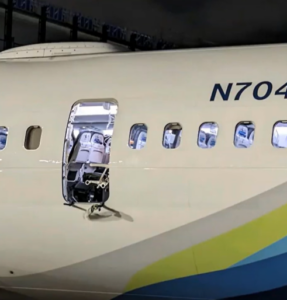
The emergency exit door plug separated from the two-month-old Boeing 737-9 MAX due to faulty installation, the National Transportation Safety Board confirmed.
A door plug on an emergency exit on a two-month-old Boeing 737-9 MAX blew off the airplane as it passed more than 16,000 ft shortly after takeoff from Portland (OR). Nobody was killed and only a few injuries occurred. The flight crew made an emergency landing in Portland a few minutes later.
Within days, the focus for the incident landed on Spirit AeroSystems, which makes the fuselages and installed the door plug, and on Boeing, which completed final assembly at its Renton (WA) 737 plant. Quality assurance, or “quality escape” in aviation jargon, was suggested to be issues at Spirit and Boeing.
LNA’s Bjorn Fehrm quickly concluded that four bolts meant to hold the door plug in position after installation were missing. The bolts are designed to prevent the plug from moving upward off flanges that hold the plug in place in the fuselage opening.
The NTSB’s investigation confirmed that these four bolts were missing after Boeing removed and reinstalled the plug to fix a quality escape from Spirit affecting the plug. Boeing employees failed to reinstall the plug.
Removing the plug is not a standard final assembly procedure. It’s called an “unplanned removal.” There is a specified procedure to reinstall an unplanned removal. It appears that Boeing failed to follow its own procedures.
LNA on Jan. 15 detailed the procedures for unplanned removals and reinstallation.
Related articles
- Unplanned removal, installation procedures at Boeing
- 737 incidents prompt new scrutiny at Boeing
- Alaska 1282 isn’t a “MAX” story, it’s a quality assurance issue at Boeing and Spirit
Culture key to latest Boeing MAX crisis: panelists
By Scott Hamilton
Special Coverage of the Boeing crisis
 Jan. 24, 2024, © Leeham News: What began as a non-fatal accident with an Alaska Airlines 737 MAX 9 on Jan. 5 has blown into a full crisis for Boeing. The company was once considered the gold standard of commercial aviation.
Jan. 24, 2024, © Leeham News: What began as a non-fatal accident with an Alaska Airlines 737 MAX 9 on Jan. 5 has blown into a full crisis for Boeing. The company was once considered the gold standard of commercial aviation.
Today, 171 737-9s remain grounded in the US by the Federal Aviation Administration (FAA). There is no end in sight as the FAA and National Transportation Safety Board (NTSB) investigate the accident of Flight 1282 in which a door plug (an inactive emergency exit) blew off the 10 week old Alaska MAX 9 on climb out from Portland (OR).
It is the second time the MAX has been grounded. All MAX 8s and MAX 9s were grounded from March 2019 for 21 months. This grounding only affects the MAX 9.
Evidence points to Boeing quality assurance flaws in final assembly. An anonymous Boeing employee posted on LNA a detailed scenario how Boeing failed its own processes in final assembly of the Alaska plane. (His post follows this article.)
The FAA is booting more inspectors on the ground at the 737 Renton factory. On Jan. 24, Boeing shut down the 737 assembly line for a “safety stand down.” CEOs of Alaska and United airlines, the two US carriers with the 171 MAX 9s on the ground, publicly eviscerated Boeing.
Related Articles
- Errors at Boeing (Seattle Times)
- Unplanned Removals, Installation Process at Boeing (Leeham News)
- Boeing turns to Admiral for the second time (Leeham News)
At the first aviation conference following the Alaska incident, the Aviation Week suppliers event, some speakers called for leadership changes at Boeing.
Alaska 1282 isn’t a “737 MAX” story; it’s about quality assurance at Boeing or Spirit
Update: The Federal Aviation Administration today notified Boeing it is under investigation for potentially failing to ensure the door plug was properly installed.
By Scott Hamilton
Jan. 11, 2024, © Leeham News: Alaska Airlines Flight 1282’s (AS 1282) decompression last Friday on a Boeing 737-9 MAX understandably brought new focus and doubts about the MAX program.
The MAX was grounded by the Federal Aviation Administration for 21 months after the March 2019 crash of an Ethiopian Airlines 737-8 MAX. This followed an October 2018 crash of a Lion Air MAX 8 under similar flight conditions. The two accidents were traced to the root cause of a mis-designed Maneuvering Characteristics Augmentation System, or MCAS.

Note: This data is based on October 2023 information. Full year 2023 data is not available at this writing.
When a door plug for an inactive emergency exit blew out of AS 1282 at 16,000 ft minutes after departure from Portland (OR), it meant trouble for Boeing and confidence in the MAX. Fortunately, no fatalities and only a few minor injuries resulted from the decompression. The flight returned to Portland and landed safely.
Alaska grounded its fleet of 65 MAX 9s within hours. United Airlines followed the next day. It has more MAX 9s—79—than any other airline. Shortly after United’s action, the FAA made it mandatory: the MAX 9s would remain grounded until inspections and fixes, if required, could be completed. A few other international airlines followed suit.
But as information emerged through Tuesday of this week, it became clear that this story is not a “MAX” story. It’s a story about quality assurance at Boeing or Spirit AeroSystems, the maker of the 737 fuselages and the plug door.
737 incidents prompt new scrutiny at Boeing
By the Leeham News Team
Analysis
Jan. 8, 2024, © Leeham News: Following in the footsteps of the 737 rudder bolt omission inspection just last month, we have the Jan. 5 incident on Alaska Airlines Flight 1282 in which an emergency exit plug door blew off the airplane at 16,500 ft. This may indicate another quality assurance failure at either Boeing or Spirit AeroSystems.

The door plug design used on the Boeing 737-900/900ER, 737-8-200 and 737-9. Credit: Boeing, via the National Transportation Safety Board.
We don’t know if this is a Boeing problem, a Spirit problem, a bolt manufacturer problem, or an Alaska Airlines problem. It’s way too soon in the investigation to draw conclusions. Certainly, because it’s Boeing’s name on the airplane, and especially given the MAX history, people are jumping to the conclusion that Boeing screwed up again. While this may ultimately prove true, LNA is not at all prepared to conclude today that this is the case.

Illustration of the bolt locations securing the Boeing 737-9 door plug to the airframe. Credit: Capt. Chris Brady.
The flight left Portland (OR) for Ontario (CA) about 4:30pm. Six minutes later, as the two-month-old Boeing 737 MAX 9 was climbing through 16,500 ft to cruising altitude, the inactive emergency exit plug door, aft of the wing on the left side of the plane, separated from the aircraft. Decompression followed, with an emergency descent and landing back at Portland. There were no serious injuries.

The area where the door plug and cell phones fell from Alaska Airlines Flight 1282. Credit: Google Earth, NTSB.
Boeing and Spirit have been plagued in recent years by quality “escapes.” Inspection and quality assurance may be the culprit again. The official investigation will take some time. The rapid issuance of the Emergency AD Note mandating only a one time inspection is a logical response to something having been misassembled, with the fix being to verify it is assembled per drawing. Whether this is another piece of poor workmanship not being caught by inspection remains to be seen.
The following analysis was compiled by LNA’s news team.
UPDATE: Calhoun upbeat on cash flow despite fifth consecutive quarterly loss
By Bryan Corliss
Oct. 26, 2022, (c) Leeham News: The Boeing Co. posted a loss from operations of nearly $2.8 billion for the third quarter, citing losses on fixed-price defense development programs that offset an overall 4% growth in revenues.
 The consensus of Wall Street analysts earlier this week was that Boeing would announce profits of 13 cents a share and would break a streak of four consecutive losing quarters. Instead, Boeing posted a loss of $5.49 a share.
The consensus of Wall Street analysts earlier this week was that Boeing would announce profits of 13 cents a share and would break a streak of four consecutive losing quarters. Instead, Boeing posted a loss of $5.49 a share.
However, in a conference call with stock analysts later in the morning, Calhoun was upbeat, emphasizing Boeing’s positive operating cash flow of nearly $3.2 billion for the quarter.
“This quarter was a big one for us,” he said. “We hit a marker … to generate positive cash flow.”
Boeing booked losses of roughly $1.95 billion on two defense programs, CFO Brian West said: KC-46 tankers and new Air Force One presidential transports. Both are fixed-price contracts for commercial jet conversions that forced Boeing to eat any cost overruns.
“We aren’t embarrassed by them,” Calhoun said. “They are what they are.”
But in an interview with CNBC’s Phillip LeBeau Wednesday, Calhoun said Boeing will not do fixed-price defense contracts in the future. “That is not our intent.”
Summary:
- BCA: 737 and 787 deliveries resume; engines in short supply
BDS: ‘Labor instability’ hurts key programs
Calhoun: Boeing ‘supports China’ but is re-marketing planes
Read more
Exclusive: No change in Scope Clause in new United pilot contract that would have allowed E175-E2
By Scott Hamilton
June 24, 2022, (c) Leeham News: There is no change to the Scope Clause in the new United Airlines pilot contract governing the number of regional jets that can be operated by regional partners, LNA confirms.
There is also no change in the weight of the aircraft allowed, a blow to Embraer’s hopes for the E175-E2. The E2 is heavier than the E175-E1, which entered service in 2004. Embraer designed the E2 to be used with the Pratt & Whitney GTF engine. The GTF is more economical than the E1’s GE CF34, quieter, and emits fewer emissions. But it is slightly heavier than the Scope Clause contracts permit. The USA is virtually the only market for the E175-E2.
Pontifications: Horizon’s plan to focus on single fleet type appears a blow to TPNG hopes
March 29, 2022, © Leeham News: Alaska Air Group announced last week that its subsidiary, Horizon Air, will retire 32 De Havilland Canada (DHC) Dash-8-400s by the end of 2023. The regional airline will go to a single fleet type, the Embraer E175-E1. AAG owns some of the 175s. Regional partner SkyWest owns and operates others.
The plan adds to the struggles of DHC to return to service -400s stored at the start of the COVID pandemic. At the end of 2021, there were more than 150 stored. As of last week, this number was down to 142, according to the ch-aviation data base. Another 17 were in maintenance. There were 398 in service. The number stored represents 25% of the -400 fleet.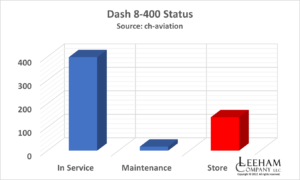
Consolidating to a single fleet type doesn’t bode well for Embraer’s efforts to win Alaska/Horizon as a launch customer for its new TPNG. This advanced turboprop, proposed in 70- and 90-seat versions, has engines mounted on pods at the rear in the latest concept shown to the industry. A new engine will replace the aging but reliable Pratt & Whitney PW-series used on the Dash 8 and ATR-42/72. P&W, GE and Rolls-Royce are developing a new generation engine.
Embraer wants to launch the program this year with a proposed entry into service of 2027.
HOTR: When will Boeing return 737 rates to pre-grounding level?
By the Leeham News Team
March 5, 2022, © Leeham News: When will Boeing return the 737 production levels to the pre-grounding rate of 52/mo?
It’s a question that is of key interest to the industry, employees, and the always-looming investment community. Boeing hasn’t given any guidance beyond the 31/mo target sometime this year. The rate is currently in the low-to-mid 20s.
 But if one carefully watches the Boeing supply chain, some of these publicly held companies give information to their own investors in public forums from which one can look at Boeing.
But if one carefully watches the Boeing supply chain, some of these publicly held companies give information to their own investors in public forums from which one can look at Boeing.
For example, Allegheny Technologies Inc., more commonly known as ATI, gave very specific guidance during its Feb. 17 investors’ day. Seaport Global, a boutique shop, covers ATI and was the first to report the guidance.
“ATI stated that, ‘in line with our customers’ forecasts…when we look at 2025, we see single-aisle going to 127/mo,’” Seaport wrote. In this context, ATI’s customers are Airbus, Boeing, and the three engine OEMs. Airbus is considering an A320 family rate 75/mo in 2025. Simple math says Boeing’s MAX rate will be 52/mo by then. In its note, Seaport was more conservative, predicting rate 47 by 2025.
Carbon footprint: Regional jet versus turboprop, how large is the difference?
Subscription Required
By Bjorn Fehrm
Introduction
January 27, 2022, © Leeham News: Last week, we kicked off a series of articles where we will measure what difference our choice of flying makes to the primary Greenhouse gas emission, CO2.
We have upgraded our airliner performance model for the series to give a direct output of the CO2 emissions for the flights in different phases.
We start this week by comparing a typical domestic feeder flight of 300 nm, with an example route of Cleveland to Chicago O’Hare. What will be the time differences? And the fuel burn and CO2 emission difference?
To make it a fair comparison, we’ll use present generation aircraft flying on the US market, the Embraer E175 and De Havilland’s DH 8-400. We will fly the DH 8 at a high-speed cruise to keep the flight time differences within 10 minutes.
Summary
- As expected, the turboprop is the more efficient mode of transportation on the route. It consequently emits less CO2 per transported passenger.
- With new, more comfortable turboprops in the works, the drive for sustainability could see a return of the turboprop to the US market.
Boeing, Alaska team for next round of ecoDemonstrator research
By Scott Hamilton
June 3, 2021, © Leeham News: Boeing and Alaska Airlines today outlined a five month ecoDemonstrator program in a series of tests designed to “green up” commercial aviation.
Boeing partnered with airlines and suppliers beginning in 2012. Alaska is the eighth airline to participate. A Boeing 737-9 will be the current platform.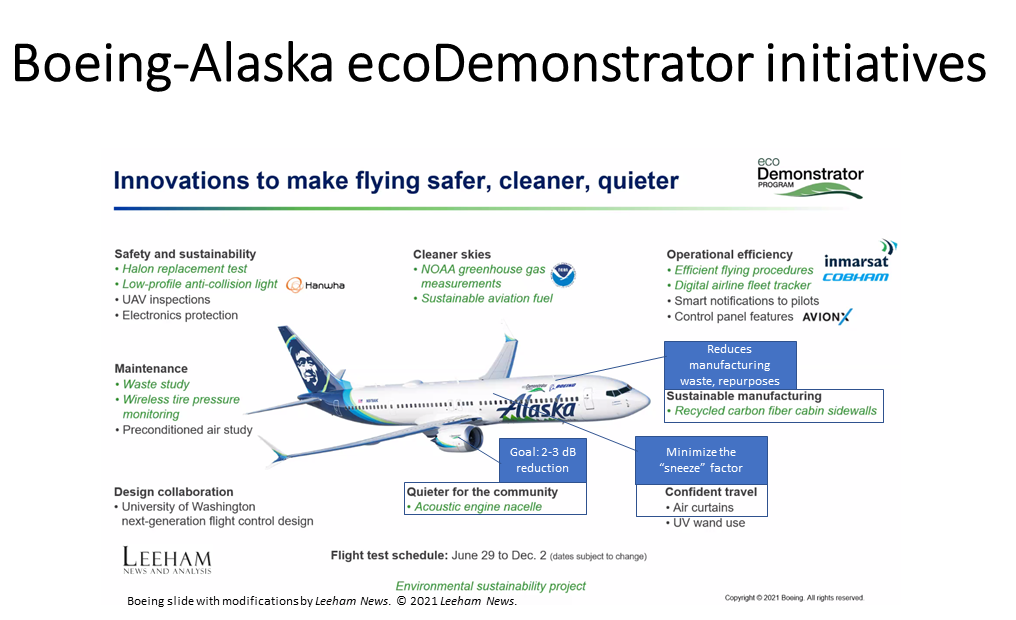
Boeing will flight test 20 technologies and ideas with Alaska beginning June 29 and ending Dec. 2.
Not all ideas fall strictly within “new technologies.” Some are weight-reduction initiatives that aggregate to lower airplane weight, which in turn reduces fuel burn. This in turn reduces carbon emissions.
But other ideas directly go to environmental efforts addressing noise, emissions and now COVID infectious worries.


